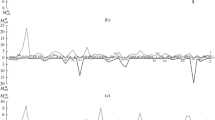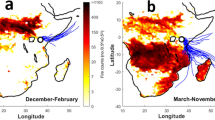Abstract
An emission inventory for fine particle aerosol carbon has been constructed for the Metropolitan Los Angeles area and compared to the results of ambient sampling. Information on the level of source activity, total aerosol emission rate, particle size and chemical composition was used to estimate the mass emission rate of particulate organic and elemental carbon in this urban area. It was found that carbonaceous particle emissions to the atmosphere arise from more than fifty classes of mobile and stationary air pollution sources. Emission data for elemental carbon at present contain significant uncertainties. Methods for verifying the consistency of carbonaceous aerosol emission inventories thus are important. Verification tests based on comparison of the ratio of organic carbon to elemental carbon and lead in source emissions versus that measured in the atmosphere were developed in this paper. Using these tests, excellent agreement was found between the emission inventory and results of ambient sampling in Los Angeles during January and February 1980.
Access this chapter
Tax calculation will be finalised at checkout
Purchases are for personal use only
Preview
Unable to display preview. Download preview PDF.
Similar content being viewed by others
References
P. Cukor, L. Ciaccio, E. Lanning, R. Rubino, Environ. Sci. Technol., Vol. 6 (1972), p. 633.
D. Grosjean, S. K. Friedlander, J. Air Pollot. Control Assoc., Vol. 25 (1975), p. 1038.
B. R. Appel, P. Colodny, J. J. Wesolowski, Environ. Sci. Technol., Vol. 10 (1976), p. 359.
B. R. Appel, E. M. Hoffer, E. L. Kothny, S. M. Wall, M. Haik, Environ. Sci. Technol., Vol. 13 (1979), p. 98.
M. H. Conklin, G. R. Cass, L-C Chu, E. S. Macias, “Wintertime Carbonaceous Aerosols in Los Angeles: An Exploration of the Role of Elemental Carbon,” In: E. S. Macias and P. Hopke (eds.) Chemical Composition ofAtmospheric Aerosols: SourcelAir Quality Relationships, American Chemical Society, Washington, D.C. /981.
R. G. Delumyea, L-C Chu, E. S. Macias, Atmos. Environ., Vol. 14 (1980), p. 647.
L. Gundel in T. Novakov (ed.), “Proceedings, Carbonaceous Particles in the Atmosphere,” Lawrence Berkeley Laboratory; Berkeley, California, (1978), p. 91.
W. R. Pierson, P. A. Russell, Atmos. Environ., Vol. 13 (1979), p. 1623.
S. L. Hiesler, R. C. Henry, J. G. Watson, G. M. Hidy, “The 1978 Denver Winter Haze Study, Vol II, Final Report,” Environmental Research and Technology Inc., Document P-5417–1, Westlake Village, California, 1980.
G. T. Wolff R. J. Countess, P. J. Groblicki, M. A. Ferman, S. H. Cadle, J. L. Muhlbaier, Atmos. Environ.. Vol. 15 (1981), p. 2485.
C. W. Lewis, E. S. Macias, Atmos. Environ., Vol. 14 (1980), p. 185.
H. Malissa in T. Novakov (ed.), “Proceedings, Carbonaceous Particles in the Atmosphere,” Lawrence Berkeley Laboratory, Berkeley, California, (1978), pp. 22/-228.
H. Rosen, T. Novakov, Atmos. Environ., Vol. 12 (1978), p. 923.
H. Rosen, A. D. A. Hansen, R. L. Dod, T. Novakov, Science, Vol. 208 (1980), p. 741.
H. Rosen, A. D. A. Hansen, R. L. Dod, T. Novakov, “Application of the Optical Absorption Technique to the Characterization of the Carbonaceous Component of Ambient and Source Particulate Samples,” Laurence Berkeley Laboratory, Berkeley, California, 1977.
A. P. Waggoner, R. J. Charlson, “Measurements of Aerosol Optical Properties” in P.A. Russell (ed.), “Proc. Symp. on Denver Air Pollution Study – 1973,” Vol II, document EPA–60019–77–001, U.S. Environmental Protection Agency, Research Triangle Park, North Carolina, (1977), pp. 35 – 55.
IARC Working Group, Cancer Res., Vol. 40 (1980), p. 1.
E. T. Wei, Y. Y. Wang, S. M. Rappaport, J. Air Pollut. Control Assoc., Vol. 30 (1980), p. 267.
M. S. Miller, S. K. Friedlander, G. M. Hidy, J. Colloid Interface Sei., Vol. 39 (1972), p. 165.
G. Gartrell Jr., S. K. Friedlander, Atmos. Environ., Vol. 9 (1975), pp. 279–299.
J. G. Watson Jr., “Chemical Element Balance Receptor Model Methodology for Assessing the Sources of Fine and Total Suspended Particulate Matter in Portland, Oregon,” Ph.D. Thesis, Oregon Graduate Center, Beaverton, Oregon, 1979.
A. D. A. Hansen, W. H. Benner, T. Novakov, “A Carbon and Lead Emission Inventory for the Greater San Francisco Bay Area, ” in “Atmospheric Aerosol Research Annual Report 1977–78,” Lawrence Berkeley Laboratory, document LBL-8696, Berkeley, California, 1978.
H. J. Taback, A. R. Brienza, J. Macko, N. Brunetz, “Fine Particle Emissions from Stationary and Miscellaneous Sources in the South Coast Air Basin,” KVB Inc., document No. KVB 5806–783, Tustin, California, 1979. ( Includes an important appendix volume).
G. R. Cass, P. S. McMurr_v, J. E. Houseworth, “Methods for Sulfate Air Quality Management,” Appendix A3. Environmental Quality Laboratory, Report 16, California Institute of Technology, Pasadena, California, 1980.
California Gas Report,“ (A report prepared pursuant to California Public Utilities Commission Decision Number 62260; authorship and publisher are unknown, but copies are obtainable from the Southern California Gas Company).
G. R. Cass, “Sulfur Oxides Emissions in the Early 1980’s under Conditions of Low Natural Gas Supply,”;corking paper, Environmental Quality Laboratory, California Institute of Technology, Pasadena, California, 1980.
Task Group on Lung Dynamics, Health Phys., Vol. 12 (/966), p. 173.
J. J. Huntzicker, S. K. Friedlander, C. I. Davidson, Environ. Sci. Technol., Vol. 9 (1975), p. 448.
J. L. Muhlbaier and R. L. Williams, These Proceedings, p. 185.
G. L. Ter Haar, D. L. Lenane, J. N. Hu, M. Brandt, J. Air Pollut. Control Assoc., Vo122 (1972), p. 39.
K. Habibi, Environ. Sci. Technol., Vol. 7 (1973), p. 223.
R. A. Gorse and G. T. Wolff “Effects of altitude on particulate organics and elemental carbon emissions from pre-1970 automobiles,” Motor Vehicle Manufacturers’ Association, Detroit, Michigan (in preparation).
G. R. Cass, “Lead as a Tracer for Automotive Particulates: Projecting the Sulfate Air Quality Impact of Oxidation Catalyst Equipped Cars in Los Angeles,” Environmental Quality Laboratory, Memorandum 12, California Institute of Technology, Pasadena, California, 1975.
R. L. Johnson, J. J. Shah, R. A. Cary, J. J. Huntzicker, “An Automated Thermal-Optical Method for the Analysis of Carbonaceous Aerosol,” presented at the Second Chemical Congress of the North American Continent, Las Vegas, Nevada (1980) in E. S. Macias and P. K. Hopke (eds.), Chemical Composition of Atmospheric Aerosols: Source/Air Quality Relationships, American Chemical Society, Washington, D.C., 1981. Plus additional data transmitted by letter from J. J. Huntzicker dated September 10, 1980, giving the composition of source samples. Source data were presented at that conference but are not in the proceedings volume.
R. Gorse, personal communication, Ford Motor Company, October 1, 1980. Tests on vehicles at Denver elevation show 89.6 mg/mile fine organics plus 16.1 mg/mile fine elemental C. Low altitude tests are not yet completed, but filter samples examined visually appear to be about40%lighter in shade, indicating less elemental carbon.
T. M. Baines, J. H. Somers, C. A. Harvey, J. Air Pollut. Control Assoc., Vol. 29 (1979), p. 616.
W. R. Pierson and W. W. Brachaczek, SAE Trans., Vol. 85 (1976), p. 209.
U.S. Environmental Protection Agency, “Compilation of Air Pollutant Emission Factors, Second Edition,” including Supplements 1–8, U.S. Environmental Protection Agency, document AP-42, Research Triangle Park, North Carolina, 1976.
J. B. Heywood, J. A. Fay, L. H. Linden, AIAA Journal, Vol. 9 (1971), p. 841.
R. C. Flagan, personal communication, California Institute of Technology, Pasadena, California, 1980, suggested this approximation.
J. A. Danielson, R. W. Graves, “Fuel Use and Emissions from Stationary Combustion Processes,” Southern California Air Pollution Control District, Ei Monte, California, 1976.
S. C. Hunter and H. Taback, personal communication, KVB Incorporated, Tustin, California, September 29, 1980. Filter samples taken during source tests of large natural gas combustors are not dark in color.
N. Mansour, personal communication, Southern California Edison Co., Rosemead, California. Samples taken during source tests on Los Angeles Department of Water and Power Scattergood Unit 3 while burning natural gas showed mostly iron, silica, sodium and calcium. Samples were not noticeably darkened. See source test referenced to Manfredi and Mansour [44].
M. Manfredi and N. Mansour, “Test Conducted at Department of Water and Power City of Los Angeles (Scattergood Station) 12700 Vista Del Mar, Playa Del Rey, California on September 26, 1975 — Report on the Emissions from Steam Generator No. 3 Under Natural Gas Firing,” Southern California Air Pollution Control District, Source Test Section Report No. C-2354, El Monte, California, 1975.
W. R. Pierson and W. W. Brachaczek, Rubber Chem. Technol., Vol. 47 (1974), p. 1275.
M. Morton, (ed.), Rubber Technology, Litton Educational Publishing, New York, New York, 1973.
J. R. Lynch, J. Air Pollut. Control Assoc., Vol. 18 (1968), p. 824.
E. M. Shelton, “Motor Gasolines, Winter 1978–79,” U.S. Department of Energy, document BETC1PPS-79/3, Bartlesville, Oklahoma, 1979.
G. A. DeMarrias, G. C. Holzi+’orth and C. R. Hosler, “Meteorological Summaries Pertinent to Atmospheric Transport and Dispersion over Southern California,” U.S. Weather Bureau, Technical Paper No. 54, Washington, D.C., 1965.
G. R. Cass, “Methods for Sulfate Air Quality Management with Applications to Los Angeles,” Ph.D. Thesis, California Institute of Technology, Pasadena, California, 1978.
G. C. Tiao, M. S. Phadke, M. Grupe, S. Hillmer, S. T. Liu, W. Fortney, “Los Angeles Aerometric Carbon Monoxide Data 1956–1972,” Department of Statistics, Technical Report No. 377, University of Wisconsin, Madison, Wisconsin, 1974.
M. S. Phadke, G. C. Tiao, M. Grupe, S. T. Liu, W. Fortney, S. Wu, “Los Angeles Aerometric Data on Oxides of Nitrogen 1957–1972,” Department of Statistics, Technical Report No. 395, University of Wisconsin, Madison, Wisconsin, 1974.
J. A. Cooper and C. Frazier, personal communications, NEA Laboratories, Beaverton, Oregon. Performed trace metal analysis by X-ray fluorescence.
C. Lin, M. Baker, R. J. Charlson, Applied Optics, Vol. 12 (1973), p. 1356.
J. R. Ouimette, “Chemical Species Contributions to the Extinction Coefficient, ” Ph.D. thesis, California Institute of Technology, Pasadena, California, 1980.
South Coast Air Quality Management District, personal communication, 1980. Provided copies of fuel use reports for January and February 1980 filed by all electric utilities and petroleum refiners in Los Angeles, Orange, Riverside and San Bernardino Counties, California.
K. Rosenthal, personal communication, Southern California Edison Co., 1980. Provided January and February 1980 fuel use by electric utility generating stations located in Ventura County, California.
Southern California Gas Company, “South Coast Air Basin Sales to Firm and Interruptible (Excluding Steam Electric) Customers — Year 1974,” Southern California Gas Company data tables, Los Angeles, California, 1975.
C. Marks, “The Fuel Quality and Quantity Requirements of Future Automobiles,” Engineering Staff, General Motors Corp., Warren, Michigan, presented at 1977 National Petroleum Refiners Association Annual Meeting, San Francisco, March 29, 1977.
Bureau of National Affairs, Environ. Reporter, Vol. 7(43), pp. 1638–1639; Vol. 7(52), p. 1982; Vol. 9 (3), p. 78.
H. S. Goodman et al., “A Mobile Source Emission Inventory System for Light Duty Vehicles in the South Coast Air Basin,” TRW Environmental Engineering Division, Redondo Beach, California, 1977.
K. W. Arledge and R. L. Tan, “A Heavy Duty Vehicle Emission Inventory System,” TRW Environmental Engineering Division, Redondo Beach, California, 1977.
A. Laresgoiti and G. S. Springer, Environ. Sci. Technol., Vol. 11 (1977), p. 285.
Federal Aviation Administration, “FAA Air Traffic Activity, Fiscal Year 1973,” (and 1974), U.S. Department of Transportation, 1973, 1974.
Federal Aviation Administration, “Military Air Traffic Activity Report, Calendar Year 1974,” U.S. Department of Transportation, 1974.
South Coast Air Quality Management District, “Emission Inventory — 1976,” Air Programs Division, South Coast Air Quality Management District, El Monte, California, revision of May 1979.
South Coast Air Quality Management District, “Emission Inventory of Sources at Kaiser Steel, 1976,” South Coast Air Quality Management District, El Monte, California, 1978.
D. M. Roessler, F. R. Faxvog, Appl. Opt., Vol. 19 (1980), p. 578.
Author information
Authors and Affiliations
Editor information
Editors and Affiliations
Rights and permissions
Copyright information
© 1982 Plenum Press, New York
About this chapter
Cite this chapter
Cass, G.R., Boone, P.M., Macias, E.S. (1982). Emissions and Air Quality Relationships for Atmospheric Carbon Particles in Los Angeles. In: Wolff, G.T., Klimisch, R.L. (eds) Particulate Carbon. Springer, Boston, MA. https://doi.org/10.1007/978-1-4684-4154-3_13
Download citation
DOI: https://doi.org/10.1007/978-1-4684-4154-3_13
Publisher Name: Springer, Boston, MA
Print ISBN: 978-1-4684-4156-7
Online ISBN: 978-1-4684-4154-3
eBook Packages: Springer Book Archive




